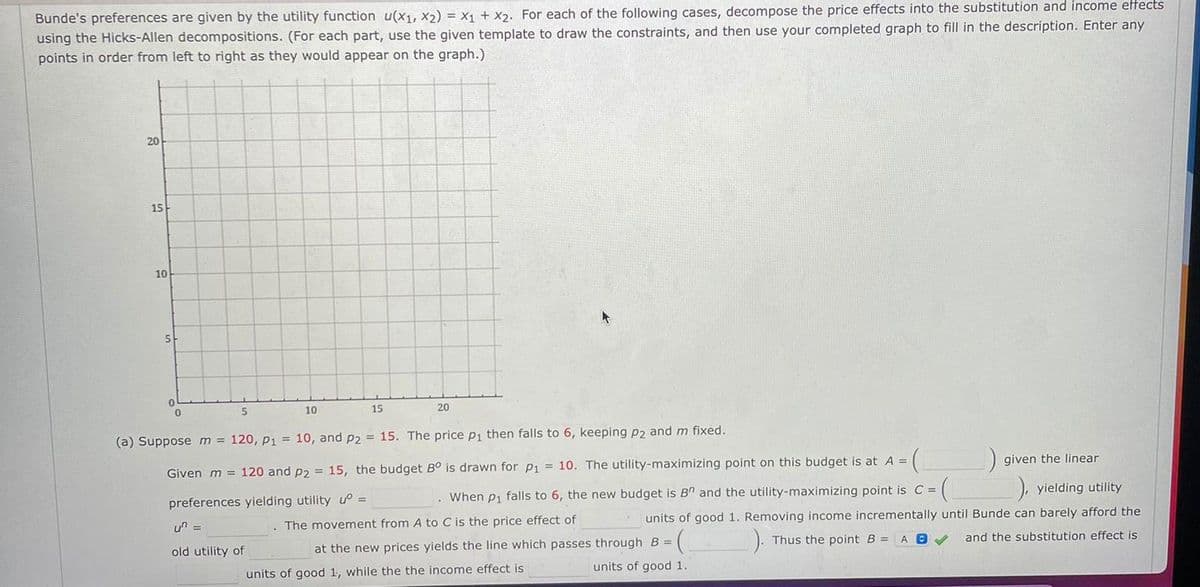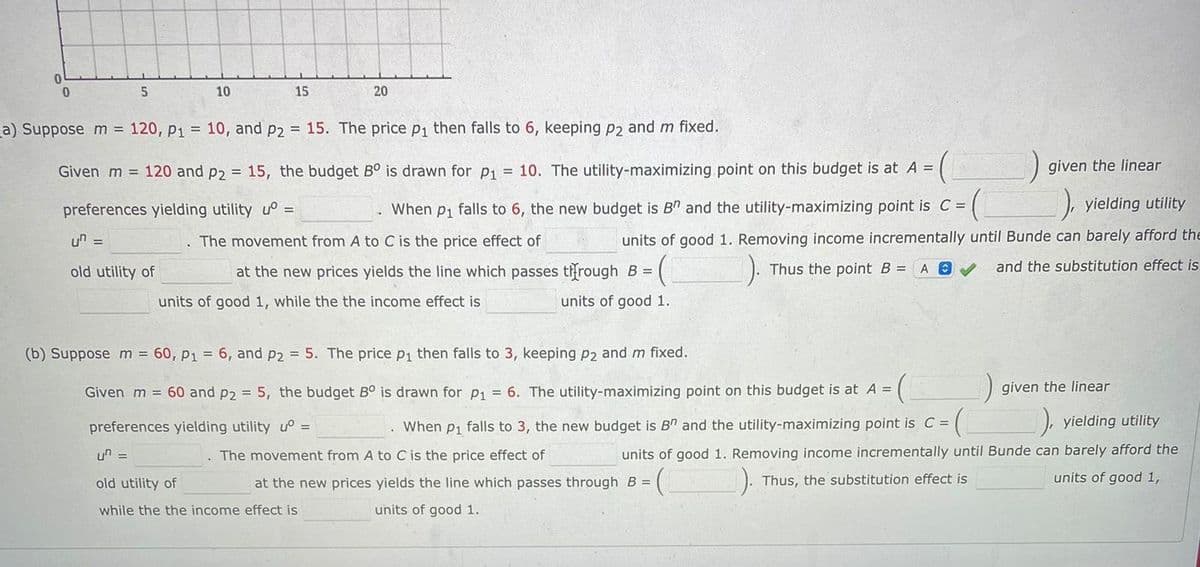Suppose m = 120, p1 = 10, and p2 = 15. The price p1 then falls to 6, keeping p2 and m fixed. Given m = 120 and p2 = 15, the budget B° is drawn for p1 = 10. The utility-maximizing point on this budget is at A = given the linear preferences yielding utility u° = . When p1 falls to 6, the new budget is B" and the utility-maximizing point is C ), yielding utility un = The movement from A to C is the price effect of units of good 1. Removing income incrementally until Bunde can barely afford th old utility of at the new prices yields the line which passes tfrough B = Thus the point B = A O and the substitution effect units of good 1, while the the income effect is units of good 1. (b) Suppose m = 60, p1 = 6, and p2 = 5. The price p1 then falls to 3, keeping p2 and m fixed. Given m = 60 and p2 = 5, the budget B° is drawn for P1 = 6. The utility-maximizing point on this budget is at A = given the linear preferences yielding utility u° = When p1 falls to 3, the new budget is B" and the utility-maximizing point is C = yielding utility The movement from A to C is the price effect of units of good 1. Removing income incrementally until Bunde can barely afford the u" = old utility of at the new prices yields the line which passes through B = ). Thus, the substitution effect is units of good 1, while the the income effect is units of good 1.
Suppose m = 120, p1 = 10, and p2 = 15. The price p1 then falls to 6, keeping p2 and m fixed. Given m = 120 and p2 = 15, the budget B° is drawn for p1 = 10. The utility-maximizing point on this budget is at A = given the linear preferences yielding utility u° = . When p1 falls to 6, the new budget is B" and the utility-maximizing point is C ), yielding utility un = The movement from A to C is the price effect of units of good 1. Removing income incrementally until Bunde can barely afford th old utility of at the new prices yields the line which passes tfrough B = Thus the point B = A O and the substitution effect units of good 1, while the the income effect is units of good 1. (b) Suppose m = 60, p1 = 6, and p2 = 5. The price p1 then falls to 3, keeping p2 and m fixed. Given m = 60 and p2 = 5, the budget B° is drawn for P1 = 6. The utility-maximizing point on this budget is at A = given the linear preferences yielding utility u° = When p1 falls to 3, the new budget is B" and the utility-maximizing point is C = yielding utility The movement from A to C is the price effect of units of good 1. Removing income incrementally until Bunde can barely afford the u" = old utility of at the new prices yields the line which passes through B = ). Thus, the substitution effect is units of good 1, while the the income effect is units of good 1.
Chapter5: Income And Substitution Effects
Section: Chapter Questions
Problem 5.5P
Related questions
Question

Transcribed Image Text:Bunde's preferences are given by the utility function u(x1, x2) = x + x2. For each of the following cases, decompose the price effects into the substitution and income effects
using the Hicks-Allen decompositions. (For each part, use the given template to draw the constraints, and then use your completed graph to fill in the description. Enter any
points in order from left to right as they would appear on the graph.)
20
15-
10
5-
5
10
15
20
(a) Supposem = 120, p1 = 10, and p2 = 15. The price p1 then falls to 6, keeping p2 and m fixed.
Given m = 120 and p2 = 15, the budget B° is drawn for p1 = 10. The utility-maximizing point on this budget is at A =
given the linear
preferences yielding utility
When p1 falls to 6, the new budget is B" and the utility-maximizing point is C =
), yielding utility
%3D
un =
. The movement from A to C is the price effect of
units of good 1. Removing income incrementally until Bunde can barely afford the
at the new prices yields the line which passes through B =
).
old utility of
Thus the point B =
and the substitution effect is
units of good 1, while the the income effect is
units of good 1.

Transcribed Image Text:10
15
20
a) Suppose m 120, p1 = 10, and p2 = 15. The price p1 then falls to 6, keeping P2 and m fixed.
Given m = 120 and p2 = 15, the budget B° is drawn for p1 = 10. The utility-maximizing point on this budget is at A =
given the linear
preferences yielding utility u° =
When p1 falls to 6, the new budget is B" and the utility-maximizing point is C =
), yielding utility
un =
The movement from A to C is the price effect of
units of good 1. Removing income incrementally until Bunde can barely afford the
old utility of
at the new prices yields the line which passes tfrough B =
Thus the point B = A O
and the substitution effect is
units of good 1, while the the income effect is
units of good 1.
(b) Supposem = 60, p1 = 6, and p2 = 5. The price p1 then falls to 3, keeping p2 and m fixed.
Given m = 60 and p2 = 5, the budget Bº is drawn for p, = 6. The utility-maximizing point on this budget is at A =
given the linear
preferences yielding utility u° =
When p1 falls to 3, the new budget is Bn and the utility-maximizing point is C =
D, yielding utility
un =
. The movement from A to C is the price effect of
units of good 1. Removing income incrementally until Bunde can barely afford the
old utility of
at the new prices yields the line which passes through B =
). Thus, the substitution effect is
units of good 1,
while the the income effect is
units of good 1.
Expert Solution
This question has been solved!
Explore an expertly crafted, step-by-step solution for a thorough understanding of key concepts.
Step by step
Solved in 3 steps

Recommended textbooks for you





